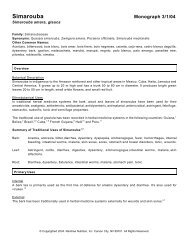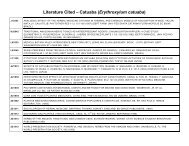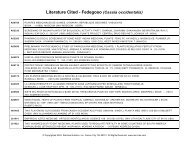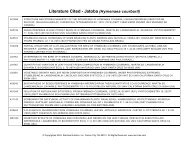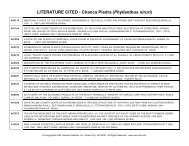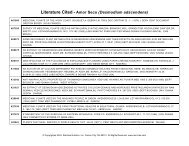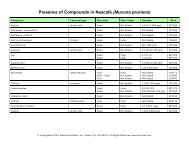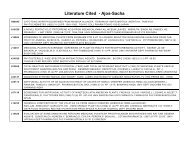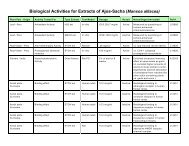Organ Specific Guide - Raintree Nutrition, Inc
Organ Specific Guide - Raintree Nutrition, Inc
Organ Specific Guide - Raintree Nutrition, Inc
You also want an ePaper? Increase the reach of your titles
YUMPU automatically turns print PDFs into web optimized ePapers that Google loves.
CUMASEBA EXTRACT<br />
Description: Cumaseba is a tropical rainforest tree that grows up to 15 meters high. It can be found in<br />
lower elevations throughout the Amazon basin area in Brazil, Peru, Colombia, Venezuela and the three<br />
Guianas (Guyana, French Guiana, & Suiname)<br />
Traditional uses by organ or system: Musculoskeletal: For rheumatism and arthritis, for fractures and<br />
dislocations, and for other painful and/or inflamed joint, muscle and/or bone conditions.<br />
Ingredients: 100% pure cumaseba bark (Swartzia polyphylla) extracted in distilled water and ethanol.<br />
Suggested Use: Take 60 drops (2 ml) 2-3 times daily or as needed.<br />
Contraindications: None reported.<br />
Drug Interactions: None reported.<br />
Other Practitioner Observations and Possible Precautions: None.<br />
Synopsis of research: (Please the online Tropical Plant Database for Cumaseba for all cited research.)<br />
In the Amazon, the bark and/or wood of the cumaseba tree is employed for rheumatism, to speed the<br />
healing of bone fractures and dislocations, and as a postpartum tonic. Indian tribes in the Amazon believe<br />
that the tree bark gives strength and prevents laziness and use it to strengthen the body during illness and<br />
to speed healing.<br />
University researchers in the United States discovered two novel isoflavanone chemicals in cumaseba<br />
and reported in two studies in 1996 and 1995 that these chemicals, as well as the crude bark extract, was<br />
able to inhibit Protein Kinase C (PKC). PKC inhibitors have attracted a great deal of scientific interest<br />
worldwide, as there is evidence that too much PKC enzyme is involved in a wide variety of disease<br />
processes including arthritis, asthma, brain tumors, cancer, cardiovascular disease and other inflammatory<br />
processes.<br />
A Brazilian research group screening plants against cancer reported that cumaseba bark was toxic to<br />
colon and lung cancer cell lines in vitro but the action was not very strong. Other scientists have confirmed<br />
through in vitro testing that cumaseba is a good antimicrobial. It has been reported to kill Mycobacterium<br />
tuberculosis, including several antibiotic-resistant strains, the stomach bacteria linked to ulcers and stomach<br />
cancer, H. pylori, several types of mouth bacteria that cause cavities and gingivitis, and other Gram-positive<br />
strains of bacteria. Cumaseba has also been documented to have actions against fungus and Candida.<br />
Most of these researchers have attributed the antimicrobial actions of cumaseba to its iso-flavone<br />
chemicals.<br />
Cumaseba is rich in flavonoids and isoflavones. It contains a significant amount of an isoflavone<br />
chemical called biochanin A which has been well studied and documented (over 150 studies published to<br />
date). Biochanin A has been documented with Selective Estrogen Receptor Modulator (SERM) actions,<br />
the ability to lower PSA levels in prostate cancer cells, cancer-preventative actions, and direct anti-tumor<br />
and cytotoxic actions against colon, breast, and prostate cancer cell lines.



